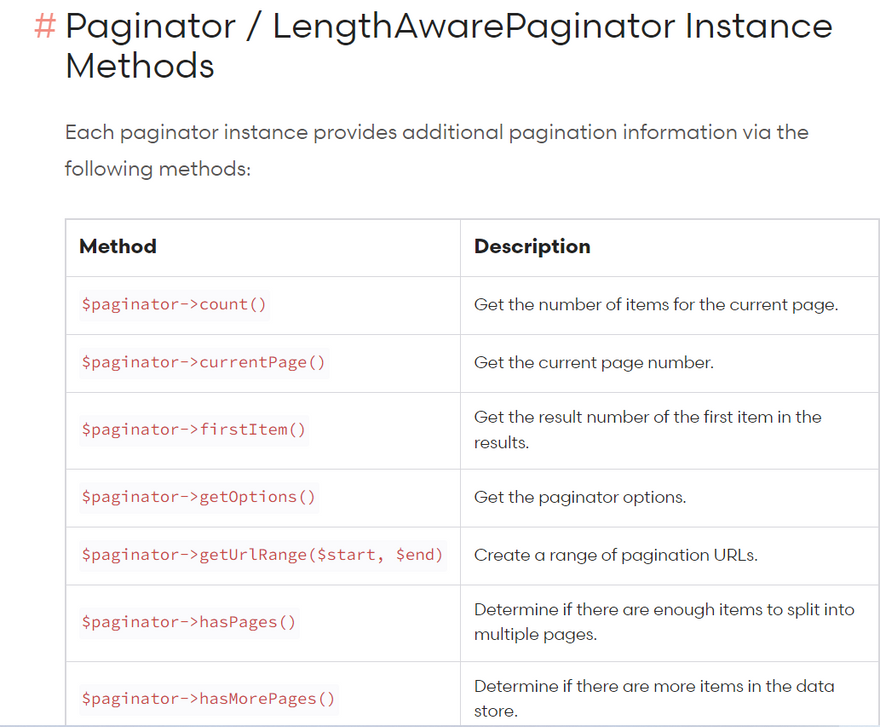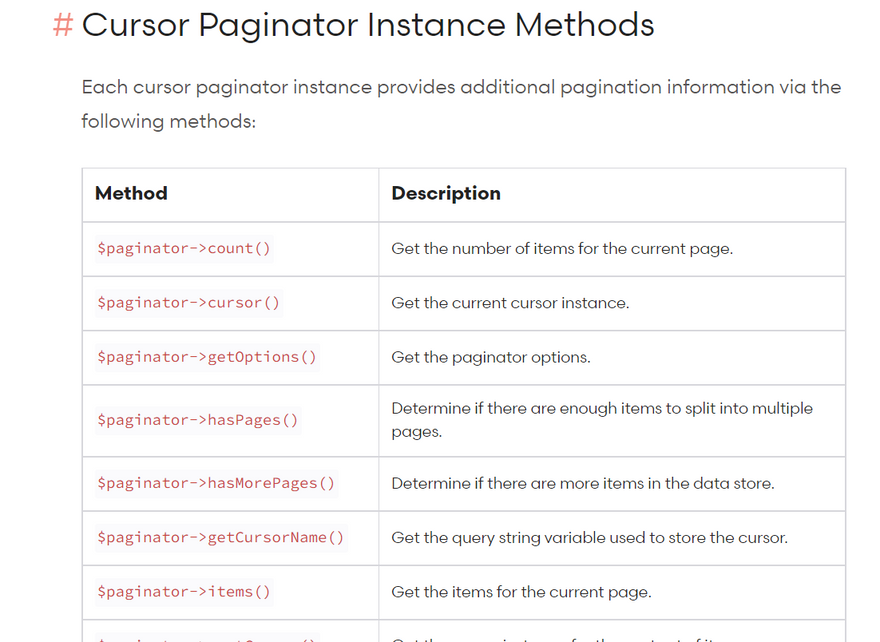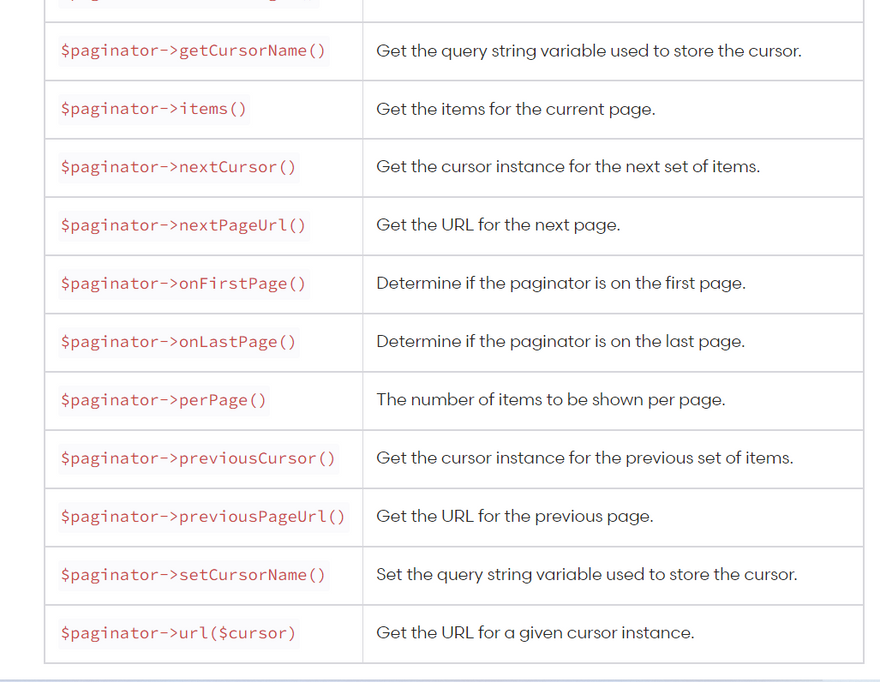Basic Usage
Paginating Query Builder Results
Paginating Eloquent Results
Cursor Pagination
Manually Creating A Paginator
Customizing Pagination URLs
Displaying Pagination Results
Adjusting The Pagination Link Window
Converting Results To JSON
Customizing The Pagination View
Basic Usage
Paginating Query Builder Results
There are several ways to paginate items. The simplest is by using the paginate method on the query builder or an Eloquent query. The paginate method automatically takes care of setting the query's "limit" and "offset" based on the current page being viewed by the user. By default, the current page is detected by the value of the page query string argument on the HTTP request. This value is automatically detected by Laravel, and is also automatically inserted into links generated by the paginator.
In this example, the only argument passed to the paginate method is the number of items you would like displayed "per page". In this case, let's specify that we would like to display 15 items per page:
<?php
namespace App\Http\Controllers;
use App\Http\Controllers\Controller;
use Illuminate\Support\Facades\DB;
class UserController extends Controller
{
/**
* Show all application users.
*
* @return \Illuminate\Http\Response
*/
public function index()
{
return view('user.index', [
'users' => DB::table('users')->paginate(15)
]);
}
}
Simple Pagination
The paginate method counts the total number of records matched by the query before retrieving the records from the database. This is done so that the paginator knows how many pages of records there are in total. However, if you do not plan to show the total number of pages in your application's UI then the record count query is unnecessary.
Therefore, if you only need to display simple "Next" and "Previous" links in your application's UI, you may use the simplePaginate method to perform a single, efficient query:
$users = DB::table('users')->simplePaginate(15);
Paginating Eloquent Results
You may also paginate Eloquent queries. In this example, we will paginate the App\Models\User model and indicate that we plan to display 15 records per page. As you can see, the syntax is nearly identical to paginating query builder results:
use App\Models\User;
$users = User::paginate(15);
Of course, you may call the paginate method after setting other constraints on the query, such as where clauses:
$users = User::where('votes', '>', 100)->paginate(15);
You may also use the simplePaginate method when paginating Eloquent models:
$users = User::where('votes', '>', 100)->simplePaginate(15);
Similarly, you may use the cursorPaginate method to cursor paginate Eloquent models:
$users = User::where('votes', '>', 100)->cursorPaginate(15);
Multiple Paginator Instances Per Page
Sometimes you may need to render two separate paginators on a single screen that is rendered by your application. However, if both paginator instances use the page query string parameter to store the current page, the two paginator's will conflict. To resolve this conflict, you may pass the name of the query string parameter you wish to use to store the paginator's current page via the third argument provided to the paginate, simplePaginate, and cursorPaginate methods:
use App\Models\User;
$users = User::where('votes', '>', 100)->paginate(
$perPage = 15, $columns = ['*'], $pageName = 'users'
);
Cursor Pagination
While paginate and simplePaginate create queries using the SQL "offset" clause, cursor pagination works by constructing "where" clauses that compare the values of the ordered columns contained in the query, providing the most efficient database performance available amongst all of Laravel's pagination methods. This method of pagination is particularly well-suited for large data-sets and "infinite" scrolling user interfaces.
Unlike offset based pagination, which includes a page number in the query string of the URLs generated by the paginator, cursor based pagination places a "cursor" string in the query string. The cursor is an encoded string containing the location that the next paginated query should start paginating and the direction that it should paginate:
http://localhost/users?cursor=eyJpZCI6MTUsIl9wb2ludHNUb05leHRJdGVtcyI6dHJ1ZX0
You may create a cursor based paginator instance via the cursorPaginate method offered by the query builder. This method returns an instance of Illuminate\Pagination\CursorPaginator:
$users = DB::table('users')->orderBy('id')->cursorPaginate(15);
Once you have retrieved a cursor paginator instance, you may display the pagination results as you typically would when using the paginate and simplePaginate methods. For more information on the instance methods offered by the cursor paginator, please consult the cursor paginator instance method documentation.
Your query must contain an "order by" clause in order to take advantage of cursor pagination.
Cursor vs. Offset Pagination
To illustrate the differences between offset pagination and cursor pagination, let's examine some example SQL queries. Both of the following queries will both display the "second page" of results for a users table ordered by id:
Offset Pagination...
select * from users order by id asc limit 15 offset 15;
Cursor Pagination...
select * from users where id > 15 order by id asc limit 15;
The cursor pagination query offers the following advantages over offset pagination:
For large data-sets, cursor pagination will offer better performance if the "order by" columns are indexed. This is because the "offset" clause scans through all previously matched data.
For data-sets with frequent writes, offset pagination may skip records or show duplicates if results have been recently added to or deleted from the page a user is currently viewing.
However, cursor pagination has the following limitations:
Like simplePaginate, cursor pagination can only be used to display "Next" and "Previous" links and does not support generating links with page numbers.
It requires that the ordering is based on at least one unique column or a combination of columns that are unique. Columns with null values are not supported.
Query expressions in "order by" clauses are supported only if they are aliased and added to the "select" clause as well.
Query expressions with parameters are not supported.
Manually Creating A Paginator
Sometimes you may wish to create a pagination instance manually, passing it an array of items that you already have in memory. You may do so by creating either an Illuminate\Pagination\Paginator, Illuminate\Pagination\LengthAwarePaginator or Illuminate\Pagination\CursorPaginator instance, depending on your needs.
The Paginator and CursorPaginator classes do not need to know the total number of items in the result set; however, because of this, these classes do not have methods for retrieving the index of the last page. The LengthAwarePaginator accepts almost the same arguments as the Paginator; however, it requires a count of the total number of items in the result set.
In other words, the Paginator corresponds to the simplePaginate method on the query builder, the CursorPaginator corresponds to the cursorPaginate method, and the LengthAwarePaginator corresponds to the paginate method.
When manually creating a paginator instance, you should manually "slice" the array of results you pass to the paginator. If you're unsure how to do this, check out the array_slice PHP function.
Customizing Pagination URLs
By default, links generated by the paginator will match the current request's URI. However, the paginator's withPath method allows you to customize the URI used by the paginator when generating links. For example, if you want the paginator to generate links like http://example.com/admin/users?page=N, you should pass /admin/users to the withPath method:
use App\Models\User;
Route::get('/users', function () {
$users = User::paginate(15);
$users->withPath('/admin/users');
//
});
Appending Query String Values
You may append to the query string of pagination links using the appends method. For example, to append sort=votes to each pagination link, you should make the following call to appends:
use App\Models\User;
Route::get('/users', function () {
$users = User::paginate(15);
$users->appends(['sort' => 'votes']);
//
});
You may use the withQueryString method if you would like to append all of the current request's query string values to the pagination links:
$users = User::paginate(15)->withQueryString();
Appending Hash Fragments
If you need to append a "hash fragment" to URLs generated by the paginator, you may use the fragment method. For example, to append #users to the end of each pagination link, you should invoke the fragment method like so:
$users = User::paginate(15)->fragment('users');





Top comments (0)